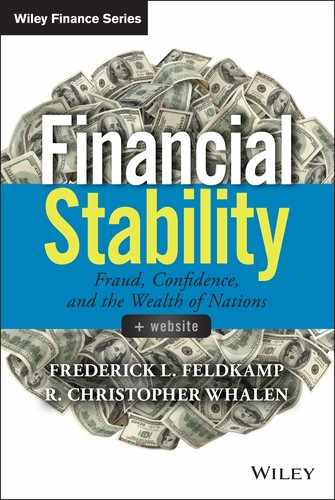CHAPTER 7
Early Deregulation: The Transactions That Replaced Depression-Era Thrifts
By the early 1970s, the Uniform Commercial Code (UCC) had been adopted in just about every state. Louisiana based many of its laws on the Napoleonic Code and was reluctant to change. In 1990 it became the last state to adopt the UCC. Until 1990, Louisiana only recognized real estate and chattel mortgages, entirely precluding pledges of incorporeal hereditaments (a fancy way of saying financial collateral, such as accounts, loans, or contract rights).
Article 9 of the Uniform Commercial Code resolved most problems caused by the Supreme Court’s 1925 Benedict opinion precluding a pledge of assets because it “imputes fraud conclusively.” In 1971 the Government National Mortgage Association (GNMA; Ginny Mae) successfully launched the first post-Depression mortgage-backed security, relying on the supremacy of a federal law that protected holders of GNMA pass-through certificates. Moreover, since GNMA only issued securities backed by mortgages that other federal agencies guaranteed, its full faith and credit guarantee of repaying investors ended debate on the security it offered investors.
GNMA constructed its program with great attention to legal details. Mortgage seller-servicers had to deliver duly endorsed mortgage notes and related papers to a specified custodian who carefully reviewed everything (and retained custody) before countersigning the guaranteed certificates for GNMA. Sellers made, and auditors confirmed, representations that assured GNMA it would not acquire defectively underwritten loans. Loan servicers were tightly controlled.
The new GNMA security created a preference for mortgages and mortgage originators that conformed to standards established by the Veterans Administration and the Federal Housing Administration.
Soon thereafter, Fannie Mae (Federal National Mortgage Association) and Freddie Mac (Federal Home Loan Mortgage Corporation; today’s primary mortgage government-sponsored enterprises, or GSEs) copied the GNMA program, with minor changes. Their securities created a similar preference for conforming mortgages that the GSEs bought from banks, mortgage bankers, and S&Ls. By 1973 it was clear that nonconforming mortgages could be priced out of the market unless a similar product opened new sources of funding for private originators of those loans.
When a major firm in the nonconforming loan business decided to attempt issuance of securities backed by the mortgages it owned, rating agencies and investment bankers (and the lawyers they consulted) recited a plethora of problems that precluded competition with Fannie Mae, Ginnie Mae, and Freddie Mac. All those problems related to the 1925 Benedict decision imputing fraud conclusively to incomplete pledges and sales of assets.
When a group of attorneys gathered to see if there was a resolution for the client, a young lawyer named Fred Feldkamp naively raised his hand and said he believed Article 9 of the Uniform Commercial Code offered a way to resolve the matter regarding pledges of mortgage notes. As a reward for his optimism he received a six-month sentence in his law firm’s library, researching each and every counterargument to the client’s concept for a nonconforming mortgage security.
The UCC had, in fact, resolved most concerns, except the issue of whether parties granted secured status could be said to have negligently entrusted an issuer of nonconforming mortgage bonds by letting it continue to collect (service) pledged mortgages. Since a mortgagor could pay the servicer and the servicer could fraudulently discharge the mortgage (and let the mortgagor sell the property) without paying the mortgage pledgees, Fred’s opinion had to exclude that possibility. The U.S. Bankruptcy Code later resolved this by specifying that servicers are permitted to hold title to a mortgage for collection purposes without conferring rights on other creditors of the servicer-pledger.
The client’s transaction closed, however, only when rating agencies noted that the exception taken involved an intentional fraudulent conspiracy between the underlying mortgagor and the servicer, and rated the transaction despite that exception. All of the parties understood that rating opinions exclude intentional fraud and trusted the particular seller-servicer in that regard.
The year of the transaction was 1973. That was when shadows of the Great Depression finally faded and nonbank finance began to blossom. From then on, the United States was on a path to a system that now, finally, supports private extensions of credit and transactions that allow sustained financial stability.
Fraud will always be a problem in a free society. By creating truly sound universal funding processes that eliminate the threat posed when fraud is combined with monopoly power (financial, political, or religious) in financial markets, however, U.S. law forces fraudulent moneychangers into an open market. With market transparency of the type sought by a revolutionary such as Justice Brandeis, good structures eventually override the threat of fraud. In a state of sustained financial stability and relative market equilibrium, loss by rescission of deceptive transfers (sale or pledge) eventually weeds out defrauders—they are driven broke.
During the decades after 1973, adoption of the U.S. Bankruptcy Code and Uniform Fraudulent Transfer Act affirmed that servicing does not preclude a valid pledge and that an unknowing fraudulent transfer is, by law, deemed a secured loan, thereby protecting innocent transferees. The 1925 Supreme Court decision continues to preclude incomplete sales as conclusively fraudulent, but that helps to support transparent accounting by requiring that incomplete transfers be reported as the secured debts (with or without recourse) that they are.
Consequently, incomplete sales cannot honestly be disguised as off–balance sheet liabilities. This would become crucially important in the 1980s and thereafter, as the distinction between a true sale and a secured borrowing became deliberately blurred to evade accounting and regulatory capital rules. This blurring of the line between sales and borrowing would lead to the 2008 failure of some of the largest financial institutions in the United States.
